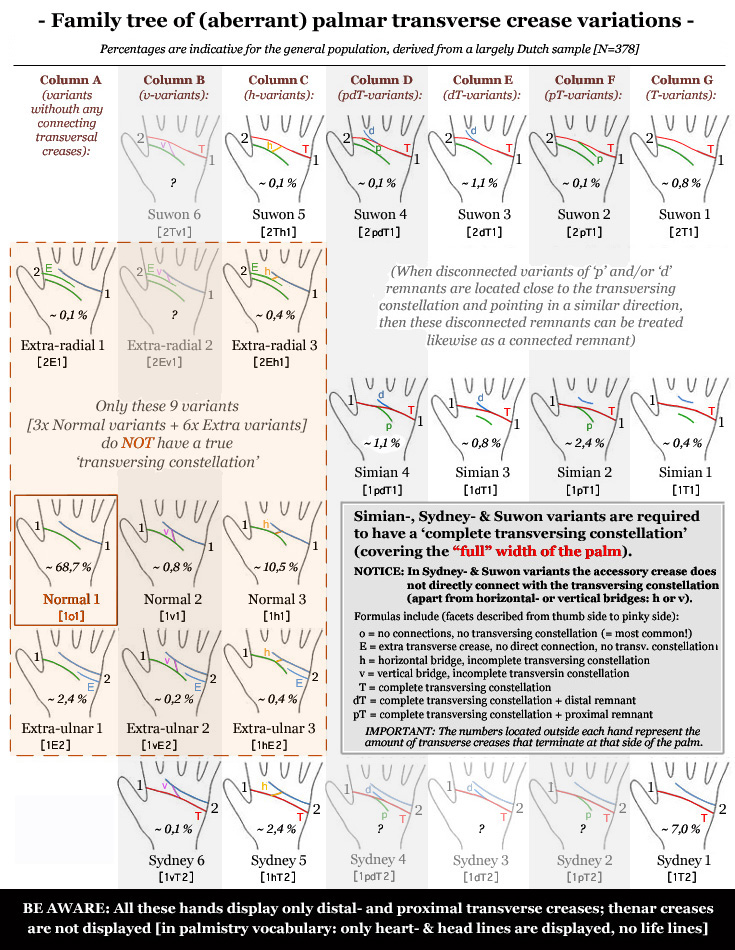|
Video: the (notorious) 'simian line'
LEARN TO RECOGNIZE & UNDERSTAND THE MOST IMPORTANT LINES IN THE PALM OF YOUR HANDS! FOR THE HAND LINES The classification of the formation combinations among the primary hand lines (palmar flexion creases) started only after Langdon Down (1909) had first described the significance of the simian crease for Down's syndrome. An overview of the historic developments since then has been described in R.S. Bali's 'Antropology of crease morphogenesis' (chapter 9). The key elements of Bali's summary are presented below, featured with a list of articles that present interesting innovations regarding the issue of classification of the major hand lines. • 1909: - R.L. Down described the link between the simian crease and Down's syndrome, in an article titled: 'Mongolian Imbecility'). • 1925: - H. Pöch presented the first attempt to describe palm crease classifications, by describing both transverse and longitudinal creases of the palm in terms of formulas. The significance of Pöch's classification was later confirmed in an ethnic study. • 1933: - J. Schaeuble described the interrelation between the primary palmar creases and the interdigital pads (volar pads). This topic was later described with many more details by S. Kimura (1986) and W.J. Babler (1991). • 1937: - W. Portius presented the first attempt to classify the simian palm crease, he described a model of four types: i.e. one transitional variant (I), two incomplete variants (II + III), and one complete variant (IV) - see the picture below. 
Other researchers have presented many alternative models for describing the simian crease, featured with a different number of types varying from three to up to eleven (M. Th. de Lestrange, 1969 - see picture below) simian line variants. 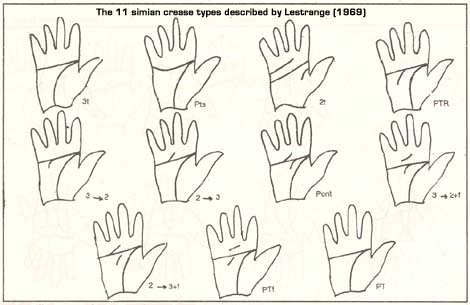
• 1949: - E. Fisher was the first to investigate the genetic aspect of simian creases with the help of twins and family data. • 1958: - K. Kimura & S. Hagiya described the first model for classifying the onset of the life line (radial longitudinal crease) combined with the onset of the head line (proximal transverse crease). The model included 5 types: opened, meeting, crossing, sub-close, and closed - see the picture below. By the way, these authors also first described the 'M' figure - which later became associated later with the Sydney line (see the 1968 article). 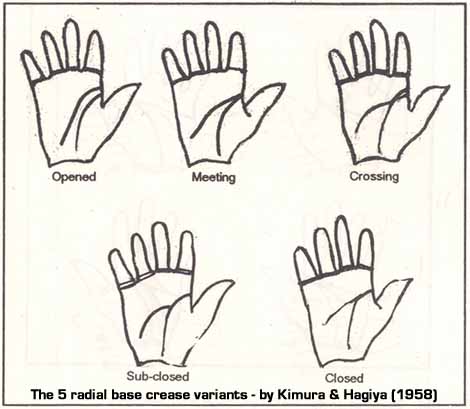
1960: - B. Leiber proposed three theoretical sets (A, B and AB) of totally 108 different formations for the 3 'primary palmar creases' - see the picture below (set A only). 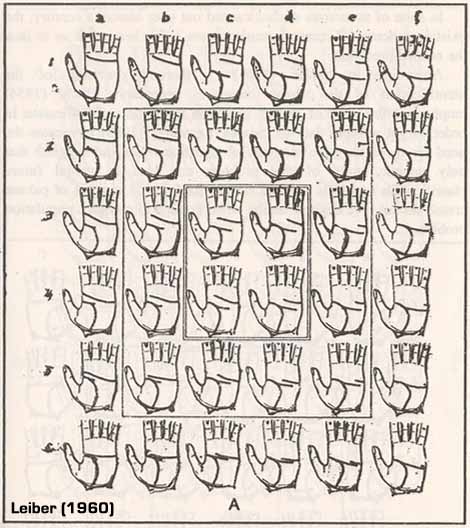
• 1968: - S.G. Purvis-Smith & M.E. Menser were the first who described the diagnostic significance of the Sydney line for congenital rubella; and later also for Leukaemia (1969) and Down's syndrome (1972). 1971: - R.S. Bali & R. Chaube advocated for a fresh approach and plead that most of the existing methods are simian crease oriented and their subsequent influence appear to have hampered the growth of a new methods of crease classifications. Their approach was to classify the palmar creases into three main categories: 1 - single radial base crease (SRBC), 2 - double radial base crease (DRBC), 3 - triple radial base crease (TRBC). The authors also introduced the term 'radial base point'. See the picture below: 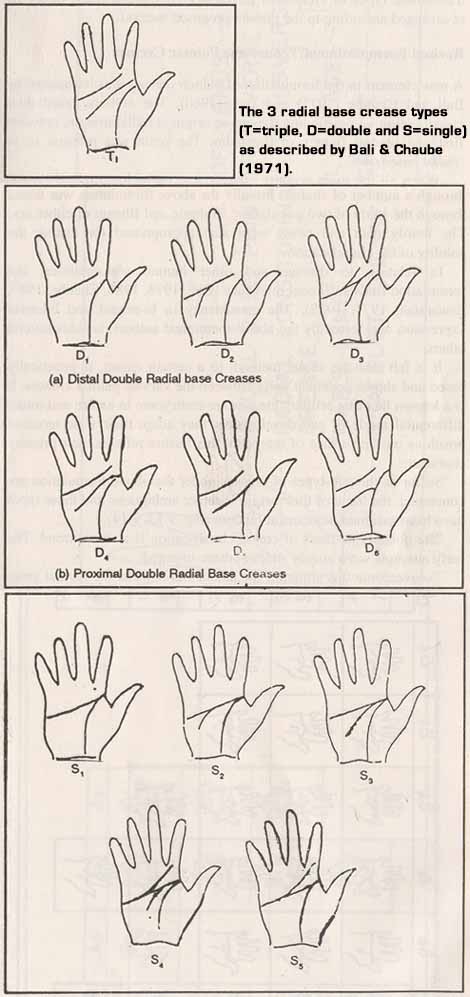
• 1977: - Eswaraiha was first to introduce a classification system for a set of longitudinal palmar creases, combining the life line (radial longitudinal crease), fate line (sagittal crease), and via lasiva (ulnar crease) - see the picture below. 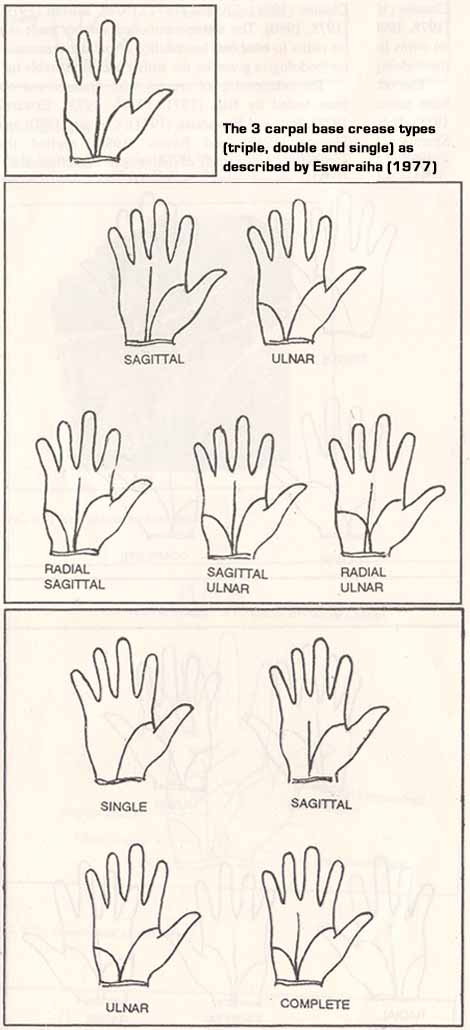
1994: - R.S. Bali introduced the term 'carpal base point' in the work Application and Methodological Perspectives in Dermatoglyphics. • 2010: - Park introduced the concept of the 'Suwon crease' and described it in the perspective of the simian line and Sydney line - see the picture below. 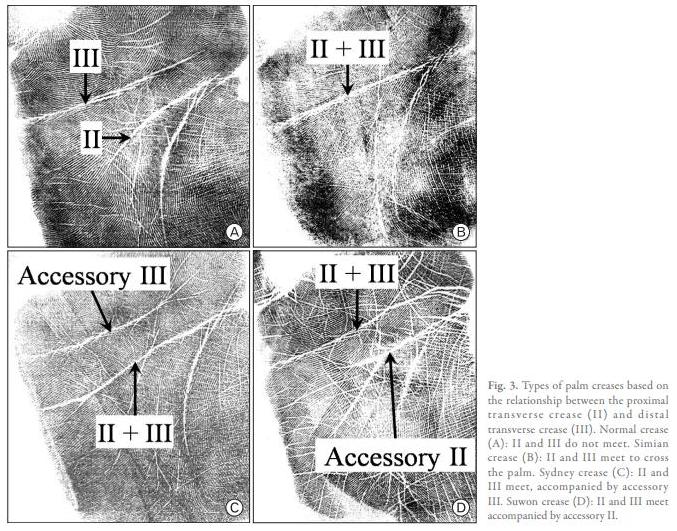
• 1972: - 'The Sydney line: a significant sign in Down's syndrome', Purvis-Smith, S.G. [PDF] • 1977: - 'Palmar Crease Variants and Their Clinical Significance', Dar. H, et.al [PDF] • 2001: - 'Dermatoglyphics and abnormal palmar flexion creases as markers of early prenatal stress in children with idiopathic intellectual disability', Rosa. A, et.al [PDF] • 2004: - 'New contributions to the study of the transverse palmary sulcus and of it's similar ridge formations', Tarca, Ana [PDF] - 'Palmprint classification using principal lines', Xiangqian Wu, et.al [PDF] • 2010: - 'Improved analysis of palm creases', Park. J.S., et.al [PDF]
|
